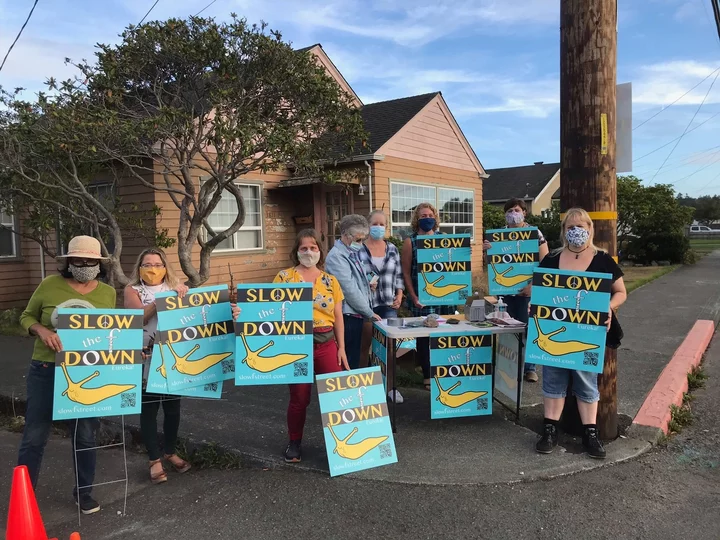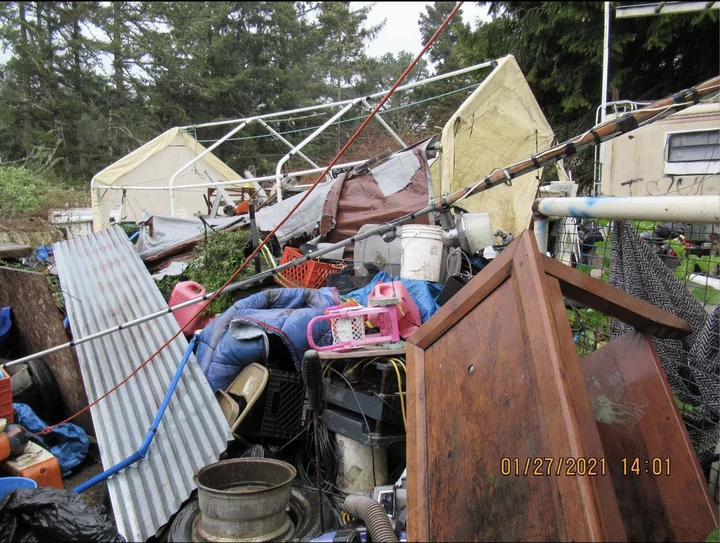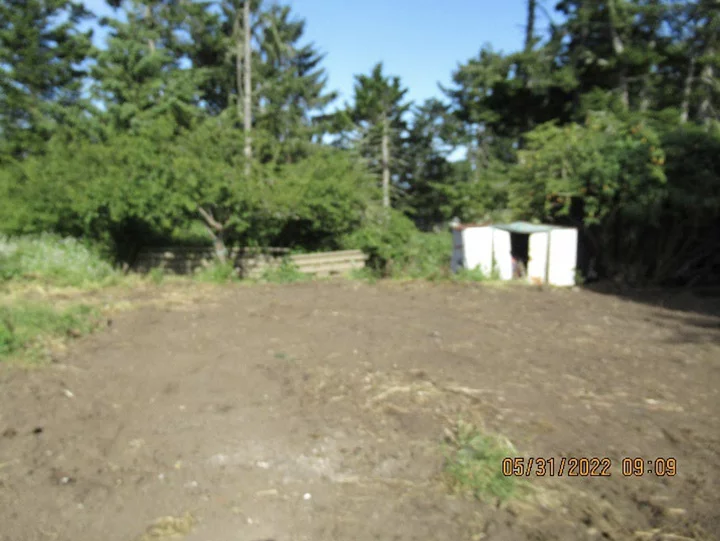Community members gather on F Street in Eureka in 2021. | Photo by Zena Bardelas.
###
The Board of Supervisors today postponed a decision over whether to spend more than $1.26 million to install a traffic signal at the accident-prone intersection of F and Oak streets.
Problems at that intersection date back years, and neighborhood residents mounted a “Slow the F (Street) Down” campaign to advocate for traffic-calming measures on the busy thoroughfare of F Street.
County staff held a series of community meetings and later commissioned a traffic study, which revealed that a signal is warranted at the intersection. Traffic signals usually cost around $500,000, Public Works Director Tom Mattson said, but this location had unforeseen difficulties involving PG&E transmission lines and drainage. Still, staff recommended approving the project.
But several members of the board raised concerns. Third District Supervisor Mike Wilson said there hasn’t really been a comprehensive analysis of potential traffic calming measures and pedestrian safety for this southern stretch of F Street, which functions as an alternate route through Eureka, one that bypasses the traffic on Broadway.
Wilson also noted that the county’s road fund currently has a negative balance of $5.9 million. He suggested reviewing other options, including pedestrian-activated crosswalks and parking restrictions as potential means of slowing vehicle traffic and discouraging the use of F Street as an alternative route through Eureka.
Fourth District Supervisor Natalie Arroyo also expressed concerns about the project’s cost and said that, based on her conversations with area residents, there’s no “universal agreement” that a new traffic signal is the right solution. She suggested analyzing other alternatives.
“I’m not opposed to considering this,” Arroyo said regarding the traffic signal. “I just would like to consider other options and make sure that that’s the right fit for this large investment.”
Mattson pushed back a bit on Wilson’s pitch to dissuade traffic on F Street.
“If you go to the prior general plan, [F Street] was actually laid out as a one-way-road couplet with E Street as a main entry and exit into the city of Eureka,” he said. “The question is, where do you want the traffic to go?” He said that his staff can certainly come back with other options, but the signal is a solution to the problems at F and Oak, albeit an expensive one.
“I need to do something at that intersection,” Mattson said.
A local resident who identified herself as Althea addressed the board, saying that if a regular traffic signal is too expensive, she’d like to see a so-called HAWK (High-Intensity Activated crossWalK) beacon installed.
First District Supervisor Rex Bohn was the lone supervisor to really push for green-lighting the traffic signal. He said that all the signals on Broadway have diverted traffic onto F, dramatically increasing traffic, and “quite a few kids” cross the street at Oak on the way to and from Grant Elementary School.
“I made a promise to a lady whose daughter was enrolled over there that we would do something about that intersection,” Bohn said, adding that he doesn’t believe studying the matter further is a responsible solution.
Second District Supervisor Michelle Bushnell asked whether the City of Eureka might be willing to help pay for a solution at the intersection, though Mattson said he doesn’t have much hope on that front. Still, Bushnell made a motion to continue the matter to a later date to explore alternative funding methods.
Wilson asked whether the continuance could also allow for exploration of other potential solutions.
“Anything to make this area safer,” Bushnell said.
The board voted 4-1, with Bohn dissenting, to continue the matter to a later date to allow more analysis, though the date was not specified.
Before and after photos of a code enforcement abatement at a property on Summit Ridge Drive in Humboldt Hill. | Images via County of Humboldt.
###
Earlier in the meeting, the county’s Code Enforcement Unit delivered its latest annual report, with manager Karen Meynell saying staff made significant progress last year toward addressing the backlog of cases involving problem properties around the county. In 2022 there were 329 new cases opened and 459 cases closed, and Meynell said there has been a dramatic decrease in new cases involving illegal outdoor cannabis cultivation.
Meynell attributed the progress made during 2022 in part to a new process that relies on automated letters informing both property owners and complainants of the status of each case. Within a week of receiving a complaint about a given property, code enforcement staff will review satellite imagery, permits and other data to determine the next course of action, Meynell said.
When there is evidence of code violations, property owners are given a “grace period” to abate the problems before a notice is served.
County staff performed four abatements in 2022, cleaning up properties with accumulated solid waste, junk vehicles, people living in un-permitted RVs and other violations. The nuisance properties included one on Montana Road in McKinleyville and one on Spears in Eureka, both of which had deteriorated after the owners died, according to Meynell.
At the third property, a 60-acre parcel on Eel River Drive in Loleta, 17 tons of waste were removed, including 40 junk vehicles and 250 tires. The fourth abatement was at a property on Summit Ridge Drive in Humboldt Hill, where staff had recorded various zoning and building code violations.
“And unfortunately,” Meynell said, “as we see with some regularity in our cases, this property is starting to exhibit a re-occurrence of the same violations, and so a new case has been started in 2023.”
Meanwhile, county staff postponed a planned abatement at a longstanding communal living property near Trinidad known as Yee Haw. Planning and Building Director John Ford explained, “There was a desire to allow the property owner to come up with an alternative plan.” However, the violations remain, “and there hasn’t been any movement to resolve it,” Ford said.
Tax liens have been assessed against the property.
Meynell said that many challenges remain for the county’s Code Enforcement Unit, perhaps chief among them being homeless encampments and people living in RVs.
“This is not news to you,” Meynell told the supervisors, “but with the housing shortage, there is no place where these people can go or relocate that would also not be problematic. And it’s difficult to remove people from their living situation with the knowledge that they have no alternatives.”
Other complaints the county receives involve conditions of “blight” — such as dilapidated buildings and overgrown vegetation — that don’t fall into any existing category of public nuisance or code violation. Meynell said the county may want to develop a blight ordinance with enforcement mechanisms.
Another challenge for the county involves complaints about vacation rentals, often involving problems with noise, parking and changes to community character.
“It’s estimated we have hundreds of vacation rentals in our county, but they’re currently not allowed by zoning except in very limited circumstances … ,” Meynell said. “The owners and operators of these properties are usually surprised to learn that vacation rentals are not allowed, especially considering how prevalent they are throughout the county and how [property owners] pay their transient occupancy taxes.”
The Planning and Building Department is in the process of developing an ordinance to address short-term rentals such as Airbnbs.
Bohn voiced frustration about properties that have been nuisances for so long that people have given up on complaining to local officials.
“So what can we do up here to help the situation?” he asked. “I’d love to say we’re doing a great job but it just doesn’t feel like it.”
Ford said it’s a matter of having the right tools to address the problems, including placing properties into receivership where necessary and the possible development of a new ordinance pertaining to blight. He also noted that staff has to “walk a pretty precise line” to avoid violating private property rights.
Wilson added that community watch groups can prove effective in documenting and addressing problem properties, and Arroyo said that the City of Eureka, where she served two terms as a city council member, has seen good results from placing properties into receivership when necessary. She said the receivers are often sensitive to housing displacement concerns and work with the public agency and property owners to try to keep tenants housed.
Fifth District Supervisor and Board Chair Steve Madrone suggested that the board might consider implementing free dumping given the sometimes prohibitive cost of hauling, say, a truckload of green waste for disposal.
“There are a few counties who actually don’t charge any dumping fees,” Madrone said. “We did this as a county back in the ‘80s when there was so much dumping happening on our county roads and highways that we actually opened up a bunch of transfer stations and for a little while they were free.”
###
A couple other odds and ends:
- As part of the consent agenda, the board approved a contract with Redwood Community Action Agency and hiring a technical consultant for a planning study for a railbanking project that will employ funds from a “Sustainable Communities” Caltrans grant to look at extending the multi-use Humboldt Bay Trail from Eureka to Tompkins Hill Road near College of the Redwoods. The planning study will be developed over approximately 18 months. [CORRECTION: This post originally said the board had approved the trail project itself, which was incorrect. The Outpost regrets the error.]
- Despite concerns from Auditor-Controller Cheryl Dillingham about the Public Works Department’s negative road fund balance, the board approved storm damage repair work for Briceland Thorne Road, which experienced roadway settlement and shoulder failure during the recent winter storms.



CLICK TO MANAGE